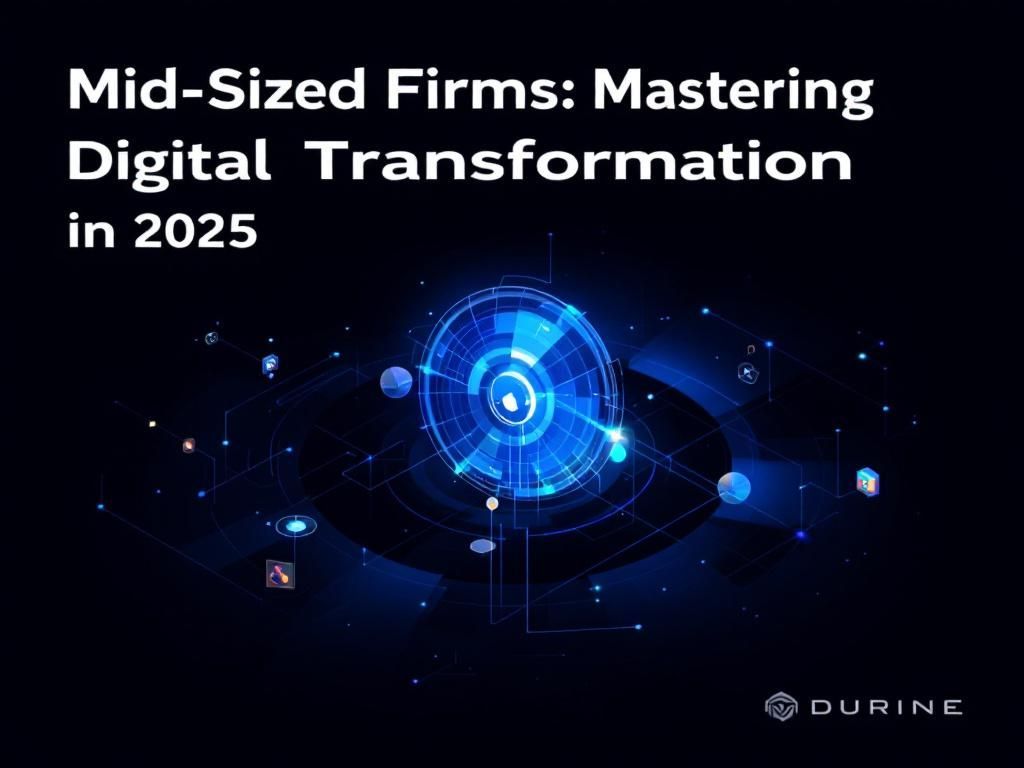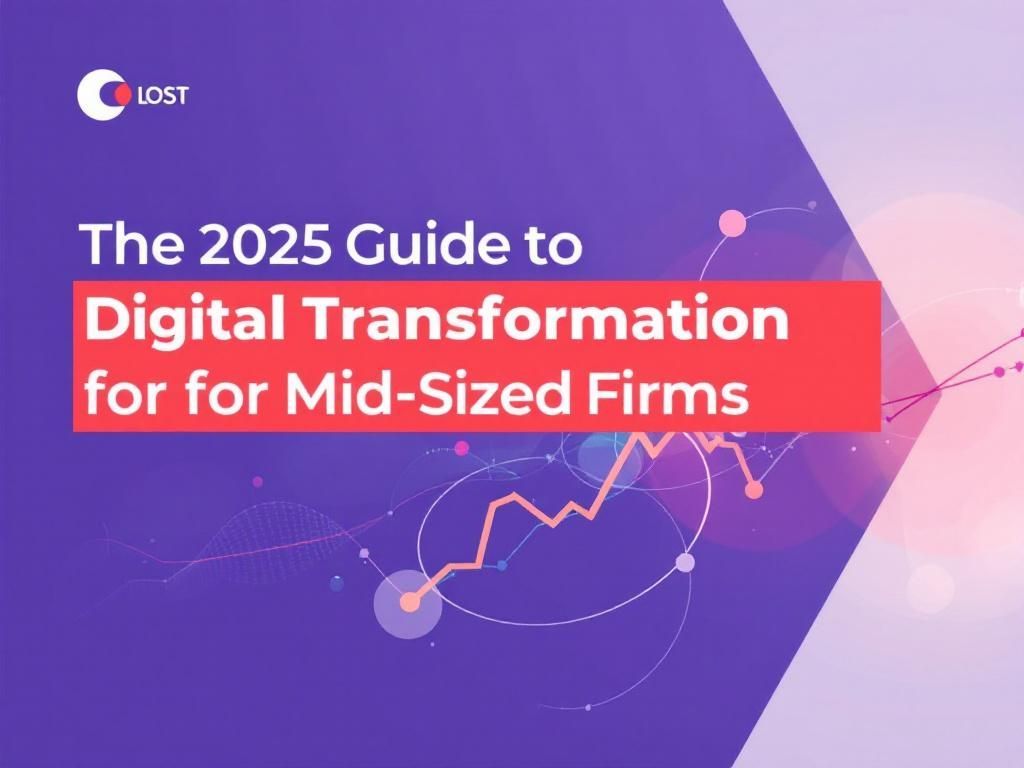Mastering Digital Transformation for Mid-Sized Firms in 2025
Explore how mid-sized firms can effectively navigate digital transformation in 2025, ensuring growth and competitiveness in a digital-first world.

As we move further into the digital age, mid-sized firms are at a crossroads. With rapid technological advancements and changing consumer expectations, these companies are tasked with not only adopting new technologies but also embedding them into their organizational cultures. Digital transformation is no longer a buzzword; it is a necessity for survival and growth in today’s competitive landscape.
Table of Contents
Understanding Digital Transformation
Digital transformation encompasses a variety of changes within an organization, from technology and processes to the overall business model. It is about leveraging digital technologies to improve operations, enhance customer experience, and drive innovation.
Key Elements of Digital Transformation
- Technology Adoption: Implementing tools and systems that facilitate better collaboration, data management, and customer interaction.
- Process Optimization: Reevaluating and streamlining business processes to increase efficiency and reduce costs.
- Culture Shift: Fostering a digital-first mindset among employees and instilling an agile approach to work.
- Customer Experience: Enhancing customer engagement through personalized experiences and improved service delivery.
The Current Landscape for Mid-Sized Firms
Mid-sized firms face unique challenges in the digital transformation journey. These challenges can stem from limited resources, lack of digital skills, and a slower pace of change compared to larger enterprises. However, they also present unique opportunities that can be leveraged for effective transformation.
Challenges Faced
- Resource Constraints: Limited budgets and personnel can hinder technology adoption.
- Resistance to Change: Employees may resist new technologies or processes, fearing job displacement or increased workload.
- Integration Issues: Difficulty in integrating new solutions with existing systems can stall progress.
Opportunities Available
Despite the challenges, mid-sized firms have several advantages when it comes to digital transformation:
- Agility: Smaller organizational structures allow for quicker decision-making and implementation.
- Close Customer Relationships: Stronger connections with customers can enable tailored digital solutions.
- Niche Markets: Many mid-sized firms operate in specialized markets, allowing them to adopt targeted digital strategies.
Implementing Digital Transformation Strategies
To navigate the complexities of digital transformation, mid-sized firms should adopt a structured approach. Incorporating the following strategies can bolster the transformation efforts:
1. Establish Clear Objectives
Before diving into technology implementation, firms need to define clear objectives. This could include enhancing customer satisfaction, improving operational efficiency, or expanding market reach.
2. Invest in Technology
Choosing the right technology is critical. Firms should consider:
- Cloud computing solutions for flexibility and scalability.
- Data analytics tools to gain insights and drive decision-making.
- Customer relationship management (CRM) systems for improved customer interaction.
3. Cultivate a Digital Culture
A company’s culture plays a significant role in the success of digital transformation. Leaders should promote a digital-first mindset by:
- Encouraging continuous learning and development.
- Recognizing and rewarding innovative ideas.
- Fostering collaboration across departments.
4. Focus on Customer Experience
The end goal of any digital transformation is to enhance customer experience. Strategies to achieve this include:
- Utilizing customer data to tailor services and marketing efforts.
- Implementing feedback mechanisms to gather customer insights and improve offerings.
- Creating omnichannel experiences that provide seamless interactions.
Case Studies of Successful Digital Transformation
Studying successful cases can offer valuable insights. Here we explore a few mid-sized firms that have excelled in their digital transformation journeys:
Case Study 1: XYZ Manufacturing
XYZ Manufacturing implemented IoT technology to monitor equipment performance in real-time. As a result:
- Operational downtime decreased by 25%.
- Maintenance costs were reduced by 30%.
Case Study 2: ABC Retail
ABC Retail enhanced its e-commerce platform and integrated AI-driven personalized recommendations. This led to:
- A 40% increase in online sales.
- Improved customer satisfaction ratings.
Measuring Success in Digital Transformation
To ensure the effectiveness of digital transformation strategies, mid-sized firms must put in place metrics to measure success. Key performance indicators (KPIs) may include:
| KPI | Description | Target Value |
|---|---|---|
| Customer Satisfaction Score | Measures overall customer satisfaction levels | Above 85% |
| Operational Efficiency Ratio | Assesses the efficiency of operations | Improvement of 20% |
| Revenue Growth Rate | Tracks year-over-year revenue growth | Minimum of 10% |
Future Trends in Digital Transformation for Mid-Sized Firms
Looking ahead, several trends are likely to shape the digital transformation landscape for mid-sized firms in 2025 and beyond:
1. Increased Adoption of AI and Automation
Artificial Intelligence (AI) and automation tools will continue to gain traction, allowing firms to streamline processes and enhance decision-making capabilities.
2. Greater Emphasis on Data Privacy
As digital interactions increase, so does the importance of data privacy. Mid-sized firms will need to prioritize data protection measures.
3. Integration of Blockchain Technology
Blockchain can offer transparency and security in transactions, making it a valuable asset for firms looking to enhance trust with customers.
Conclusion
The path to digital transformation is fraught with challenges, but the benefits it offers are undeniable. Mid-sized firms that embrace digital transformation can unlock new growth opportunities, improve operational efficiency, and deliver enhanced customer experiences. By strategically investing in technology, cultivating a digital culture, and measuring success, these organizations can thrive in an increasingly competitive landscape.
FAQ
What is digital transformation for mid-sized firms?
Digital transformation for mid-sized firms involves integrating digital technology into all areas of business, fundamentally changing how they operate and deliver value to customers.
Why is digital transformation important for mid-sized firms in 2025?
In 2025, digital transformation is crucial for mid-sized firms to remain competitive, enhance operational efficiency, and meet changing customer expectations in a rapidly evolving digital landscape.
What are the key components of a successful digital transformation strategy?
Key components include leadership commitment, a clear vision, employee engagement, data-driven decision making, and the adoption of advanced technologies.
How can mid-sized firms overcome challenges in digital transformation?
Mid-sized firms can overcome challenges by prioritizing training, investing in the right technology, and fostering a culture of innovation and agility within the organization.
What technologies should mid-sized firms focus on for digital transformation?
Mid-sized firms should focus on cloud computing, artificial intelligence, data analytics, and automation to drive efficiency and improve customer experiences.
How can mid-sized firms measure the success of their digital transformation efforts?
Success can be measured through key performance indicators (KPIs) such as customer satisfaction, operational efficiency, revenue growth, and employee engagement.



